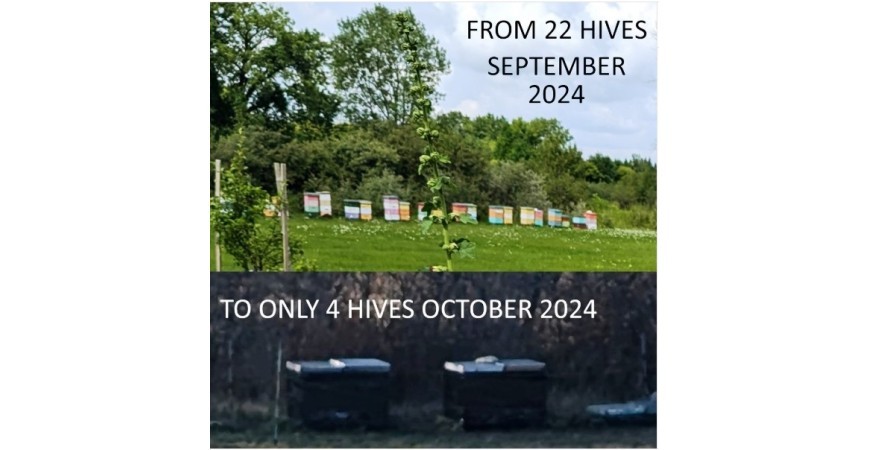2024 Trials and Tribulations
In 2024 we had some challenges in the bee yard. The overwintering from '23 went well will 16 out of the 18 colonies surviving and looking healthy. We started to feed them at the first opportunity and everything was going as usual until a local bear found us. In the 8 years we have been keeping bees we have never had a bear issue, but towards the end of April, a large black bear decided to start raiding the boxes. We still had the boxes wrapped with insulation from the winter, so this seemed to mask them a little. The bear picked on the end colony, tipped it over and broke up some of the frames in search of honey. We noticed the initial damage one evening as we looked out over the yard before retiring to bed. So flashlight in hand we picked all the pieces up and reassembled the box (luckily the queen and majority of the bees were still alive) The next morning we looked out and again, the same box was again strewn across the ground. Again on inspection the queen and bees were still clinging to frames in the grass, so we reassembled the box. That afternoon we purchased an electric fence and installed it. Later that evening we were out for supper and came home to a large black bear walking the perimeter of the fence, the deterrent worked and off he went into the night in search of more goodies....
The spring and summer rolled along and we increased our colonies to 22, the honey crop was flowing and in early September we were removing the honey supers, harvesting the honey and storing the empty frames and boxes. Then along came another pest that we hadn't met before, the wax moth. The wax moths squeak into the boxes through the smallest of gaps and lay eggs into the beeswax (they prefer wax that has had brood in it because of the extra food) and when they hatch the grubs burrow their way through the wax destroying it and leaving cocoon-like webbing everywhere. Some of the foundation had to be replaced, while some could be cleaned. Some chemicals can be utilized, but we chose to isolate each affected box with plastic in between to stop the moths going from box tox inside, taping up the gaps and also once the temperatures outside drop to below freezing this will kill off the remaining moths and grubs.
With this behind us, we kept feeding them and the bees were storing the syrup we were providing. We went about our fall mite treatments as usual and there seemed to be a lot of mites dead on the landing boards post-treatment, then the collapse started. One by one the hives lost all the bees and their weakened bodies couldn't keep going. With the reduction in outside temperatures and natural food sources, the stress of higher-than-usual mites took its toll. By the middle of October, we had 4 colonies remaining. If you know us at all you will know that we're proud and stubborn English folk, stiff upper lip and all that, but we were approached by several friends asking if they could help out, of course we said no, but we eventually submitted to pressure and set up a donation page on the website.
So with that in mind, we're asking for your support to help us replace our bee colonies and restore our thriving, sustainable bee yard.
Your kind donation will directly contribute to the revival of our farm. It will allow us to continue producing natural honey and sustainable products while maintaining a healthy ecosystem for our bees. Every contribution helps us move closer to rebuilding a vibrant and resilient bee habitat.
Richard and Karen

